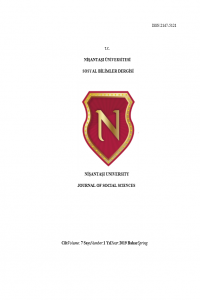Öz
Kaynakça
- Burmester, M., Mast, M., Tille, R., & Weber, W. (2010). How Users Perceive and Use Interactive Information Graphics: an Exploratory Study. Stuttgart: Stuttgart Media University.
- Ciuccarelli, P. (2012). Turning Visualisations Into Stories and "Big Pictures". In Information Graphics. Taschen.
- DK. (2013). Art That Changed the World: Transformative Art Movements and the Paintings That Inspired Them. DK Adult.
- Giardina, M., & Medina, P. (2013). Information Graphics Design Challenges and Workflow Management. Online Journal of Communication and Media Technologies, 3(1).
- Heller, S., & Womack, D. (2007). Becoming A Digital Designer: A Guide to Careers in Web, Video, Game and Animation Design. Willey.
- Kagan, S. (2002). The Birth of Art: Journey In An Archeological Controversy. Rotterdam: Erasmus Universiteit Rotterdam.
- Lengler, R., & Moere, A. V. (2009). Guiding the Viewer’s Imagination: How Visual Rhetorical Figures Create Meaning in Animated Infographics. 13th International Conference Information Visualisation.
- Pettersson, R. (2010). Information Design – Principles and Guidelines. Journal of Visual Literacy, 29(2), 167-182.
- Rendgen, S. (2012). Information Graphics. Taschen.
- Rogers, S. (2012). How Data Changed Journalism. In Information Graphics. Taschen.
- Stone, R. B. (2001). Learning and the Importance of Interactivity Information Design becomes Interaction Design. Ohio: The Ohio State University.
- UN. (1992). Agenda 21: United Nations Conference on Environment & Development. Rio de Janerio: United Nations.
- Wurman, S. R. (2012). How I Strive to Understand What It Is Like Not to Understand. In Information Graphics. Taschen.
Öz
For art and artist, protecting the sustainable balance of the environment is a binding duty. Moreover, there is a strong relationship between the solution process of environmental problems and visual design as an art form. In the solution of environmental problems, leading the public to have awareness about the subject, to gain responsibility and to develop a behavior is the indispensable requirement. The necessary information to be served into public must be built with a design language, which is emphatic, intense, thought-provoking, semantically effective, designed to be functional, and a result of a strategy. At this point, a visual designer, whose main aim is providing communication, should be involved in the process. The technology of visual design today smooths the path for ‘information architecture’ and ‘interactivity’ concepts and causes a change in the processes of conveying information, learning and education. In the present day's excessive information flow, visual designers have to clarify and simplify the presentation of the subjects and the problems, to build a bridge on the communicational gap between the public and the scientists.
Anahtar Kelimeler
visual design thinking environmental problems multidisciplinary and interdisciplinary public awareness
Kaynakça
- Burmester, M., Mast, M., Tille, R., & Weber, W. (2010). How Users Perceive and Use Interactive Information Graphics: an Exploratory Study. Stuttgart: Stuttgart Media University.
- Ciuccarelli, P. (2012). Turning Visualisations Into Stories and "Big Pictures". In Information Graphics. Taschen.
- DK. (2013). Art That Changed the World: Transformative Art Movements and the Paintings That Inspired Them. DK Adult.
- Giardina, M., & Medina, P. (2013). Information Graphics Design Challenges and Workflow Management. Online Journal of Communication and Media Technologies, 3(1).
- Heller, S., & Womack, D. (2007). Becoming A Digital Designer: A Guide to Careers in Web, Video, Game and Animation Design. Willey.
- Kagan, S. (2002). The Birth of Art: Journey In An Archeological Controversy. Rotterdam: Erasmus Universiteit Rotterdam.
- Lengler, R., & Moere, A. V. (2009). Guiding the Viewer’s Imagination: How Visual Rhetorical Figures Create Meaning in Animated Infographics. 13th International Conference Information Visualisation.
- Pettersson, R. (2010). Information Design – Principles and Guidelines. Journal of Visual Literacy, 29(2), 167-182.
- Rendgen, S. (2012). Information Graphics. Taschen.
- Rogers, S. (2012). How Data Changed Journalism. In Information Graphics. Taschen.
- Stone, R. B. (2001). Learning and the Importance of Interactivity Information Design becomes Interaction Design. Ohio: The Ohio State University.
- UN. (1992). Agenda 21: United Nations Conference on Environment & Development. Rio de Janerio: United Nations.
- Wurman, S. R. (2012). How I Strive to Understand What It Is Like Not to Understand. In Information Graphics. Taschen.
Ayrıntılar
| Birincil Dil | İngilizce |
|---|---|
| Bölüm | Makaleler |
| Yazarlar | |
| Yayımlanma Tarihi | 1 Haziran 2019 |
| Yayımlandığı Sayı | Yıl 2019 Cilt: 7 Sayı: 1 |
Nişantaşı Üniversitesi kurumsal yayınıdır.

